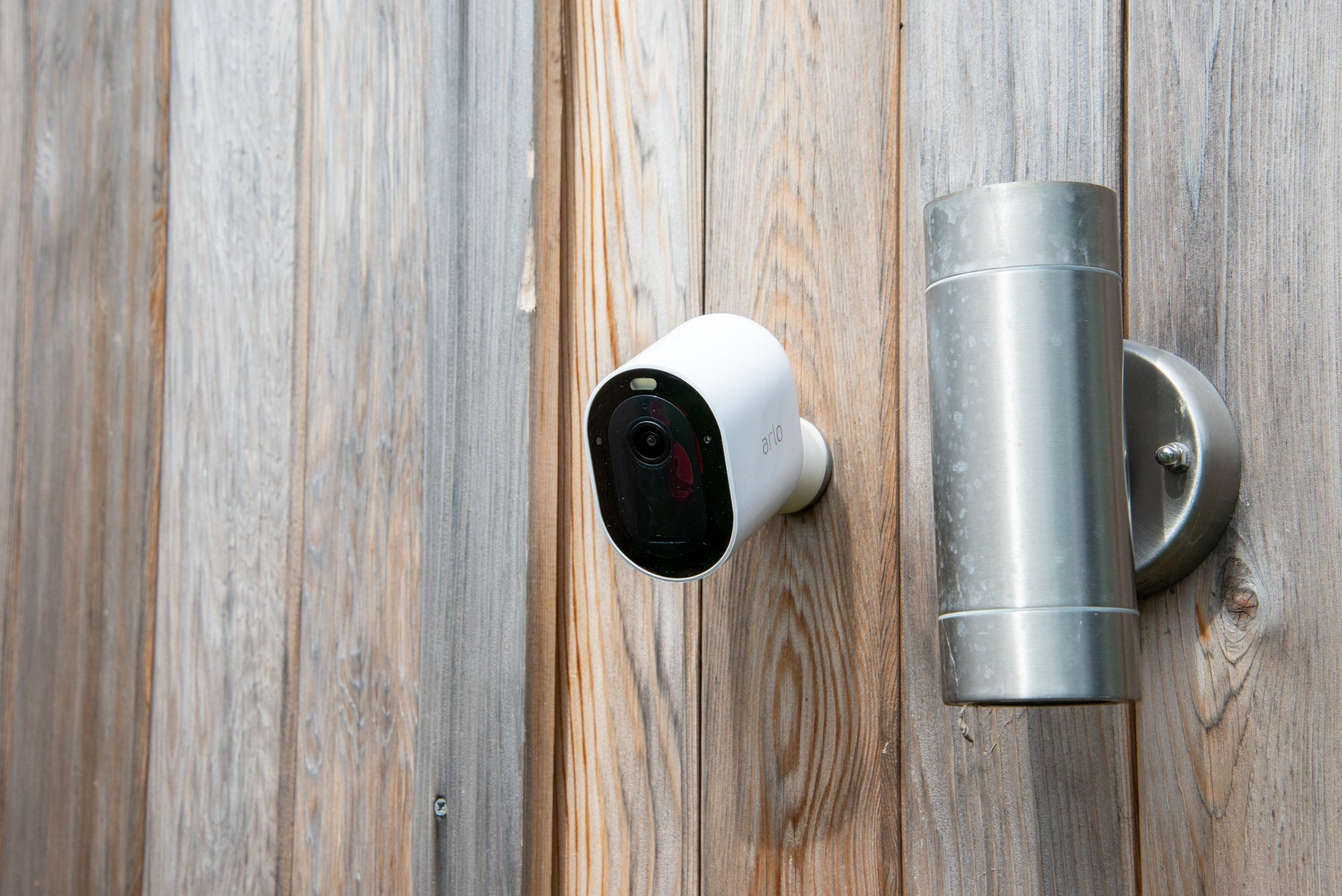Verdict
Cheaper than its predecessor yet offering the same excellent image quality and features, plus the option to connect directly to Wi-Fi, the Arlo Pro 4 (and Pro 4 XL) is the ultimate indoor/outdoor camera. It requires a subscription to get the most out of it, but the price is worth it. If you’re looking for a top-quality, battery-powered camera, then this is the model for you.
Pros
- Excellent quality
- Works with Wi-Fi or base station
- Smart features through cloud subscription
Cons
- Requires cloud subscription for biggest features
Availability
- UKRRP: £220
- USARRP: $200
- EuropeRRP: €249.99
- Canadaunavailable
- Australiaunavailable
Introduction
If there was one thing holding back the Arlo range of security cameras it was the need (and expense) of having to have a base station to which to connect the cameras. The Arlo Pro 4 addresses this issue, removing the need for a base station and hooking up directly to your Wi-Fi network. We also now have the Arlo Pro 4 XL, which is the same physical camera only housed in a larger case with an extra-large battery. As both have the same security features, I’ve covered them both in this review.
Cheaper than the Pro 3 it replaces, yet maintaining the same image quality and features, this is one of the best indoor/outdoor wireless cameras you can buy.
Design and installation
- Multiple mounting options
- Quick to install via the app
- Works with Wi-Fi or base station
Sit the Arlo Pro 4 next to the Arlo Pro 3 and you’re unlikely to spot any physical differences. Both cameras are sleek, white and lozenge-shaped, measuring 89 x 52 x 78mm. In the box you get a single magnetic mount that you can attach to a wall inside or out, although you can use the screw-mount underneath if you’d rather have a more flexible stand.
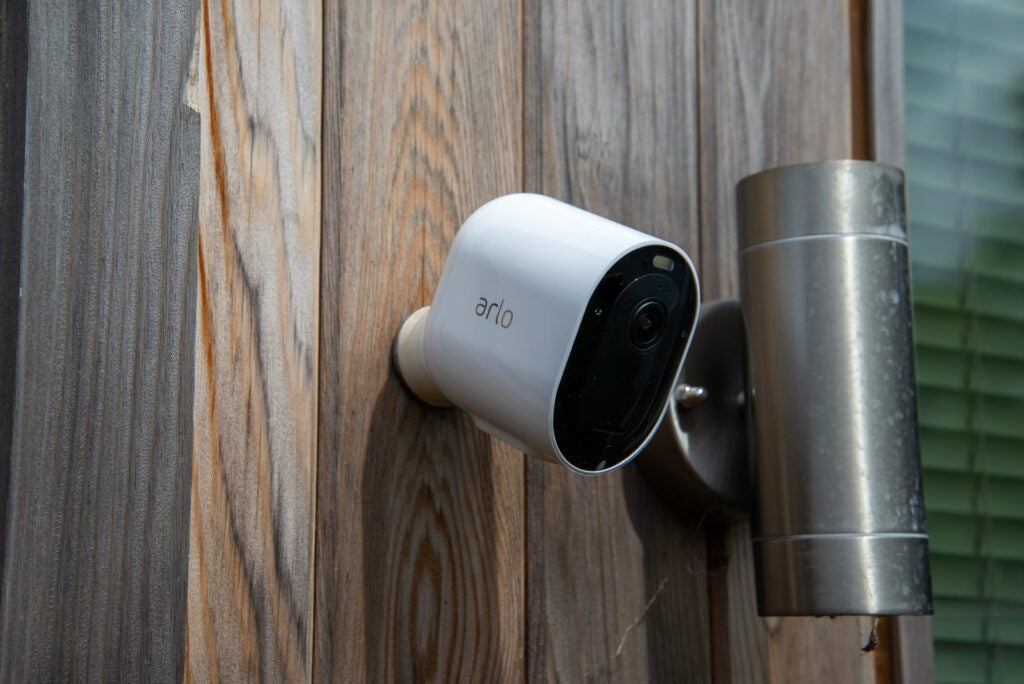
As with the rest of the Arlo range, the Pro 4 is powered by its internal battery. Pressing the release button once on the chassis slides the camera forward, but it stops at a locking position, so you can’t accidentally eject it onto the floor.
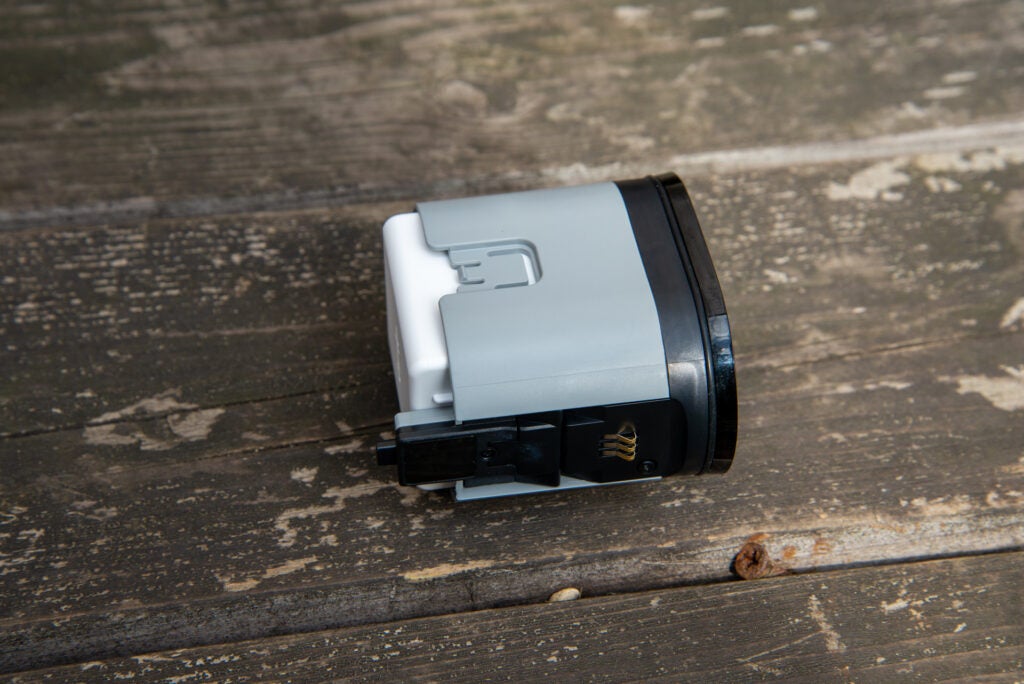
Once the centre has been ejected, you can remove the battery and charge it in an Arlo battery charger, if you have one. It may just be easier to remove the entire camera, battery installed, and use the provided magnetic cable. Optionally, you can buy a longer charging cable to permanently power the camera.
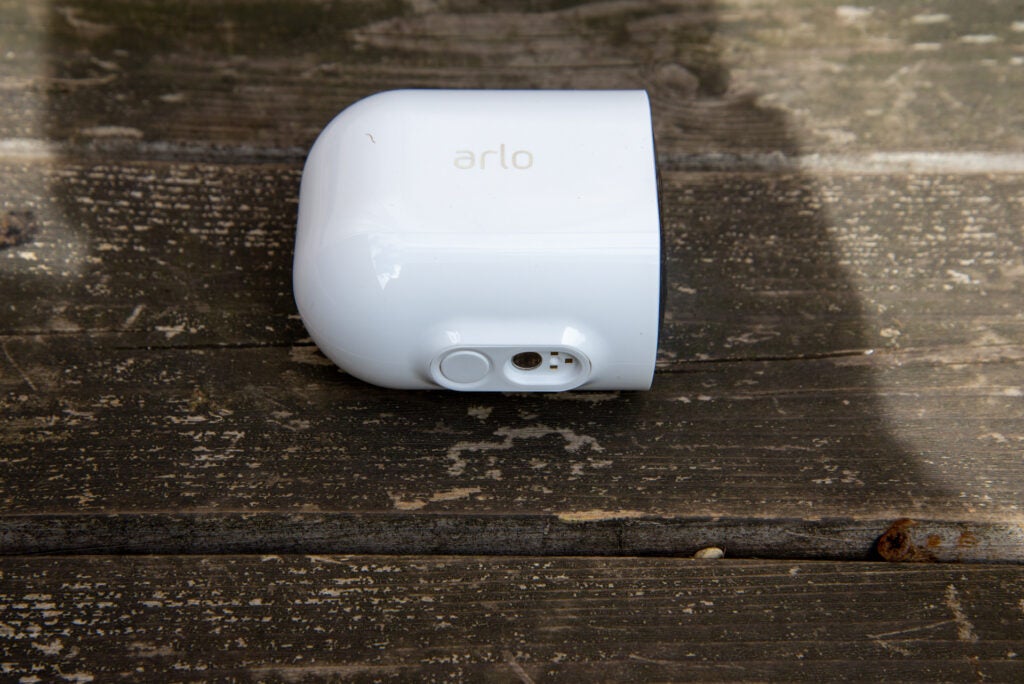
The Arlo Pro 4 XL has the same physical camera element, but this slides into a larger case that houses the larger battery. Again, you can charge the battery in an external charger or you can use the clip-on magnetic cable. Due to the size of the Pro 4 XL, it doesn’t work with the magnetic mount and must be attached to the screw mount. That’s similar to the Arlo Go 2, the cellular camera, which also has a larger battery.
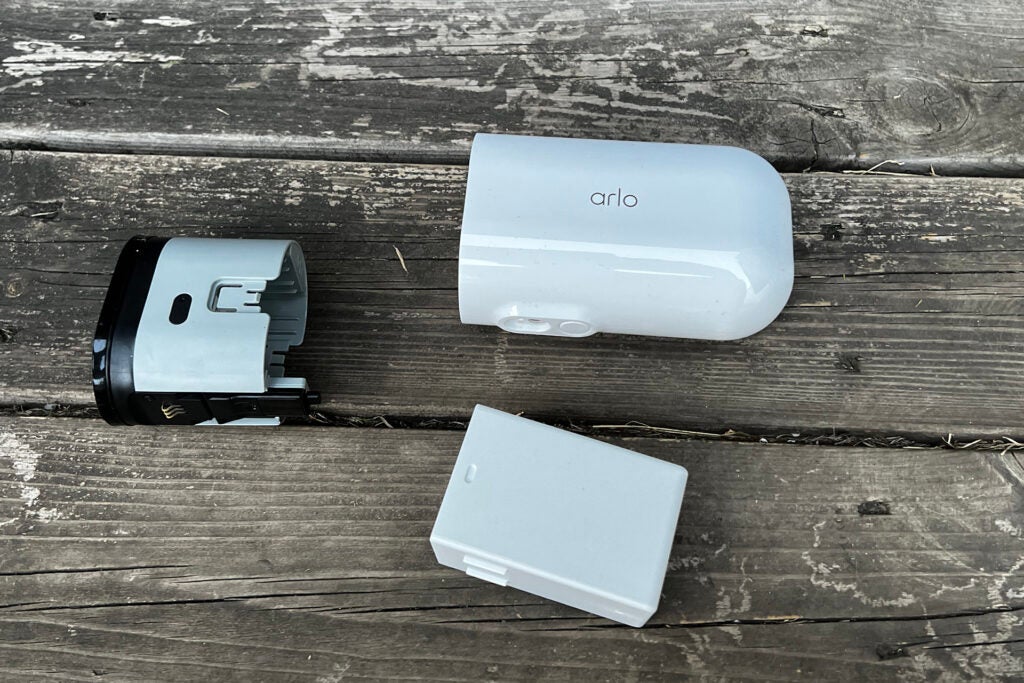
It’s with the internals that the Pro 3 and Pro 4 differ. While the Pro 3 could connect via an Arlo base station only, the Pro 4 can connect to your standard Wi-Fi network or the base station.
The former option is likely to be cheaper for many, since you don’t need any additional hardware. It can make the camera a little more flexible to control, too, as you can see below. Some may find the base useful, as you may get a stronger connection and you can add offline recording.
Features
- Arlo Secure is required for the main features
- Excellent mode control
- Clever detection and zone control
With the Pro 4 camera you get a free trial of Arlo Secure, which provides cloud recording. If you don’t want to continue paying for storage, then you’ll get basic detection only – and, if you have a base station, the option of simple offline recording.
I don’t recommend going subscription-free, since the best features come with an Arlo Secure subscription. There are now a few more options available, too, depending on the number and type of cameras you have. Arlo Secure for one camera gets you up to 2K recording (the resolution of the Pro 4) for £2.79 a month; Arlo Secure Unlimited is £8.99 a month for any number of cameras. Both get you 30-days of history.
If you want 4K recording, as offered by the Arlo Ultra, you need Arlo Secure Plus Unlimited, which is a rather expensive £12.99 a month, although storage doubles to 60 days. Personally, unless you have a 4K camera and must have it recording at top resolution, I’d go for the cheaper package.
In all cases, Arlo’s plans are a touch more expensive than those that accompany Nest – for the Nest Cam (outdoor or indoor, battery), for example, or Ring. With Ring, you also get added goodies for the Ring Alarm.
Still, there are a lot of benefits to Arlo’s system that may make a higher monthly charge appear worth the money. First, you get activity zones, so you can focus the camera on the areas you want to record, ignoring those you don’t. Without a subscription, cameras just record when the PIR motion sensor detects movement.
It’s still worth pointing your camera carefully, since all motion will wake up the camera. It’s just that activity zones determine when the Pro 4 will continue to record. Directed properly, the Pro 4 should last around 20 weeks on a charge.
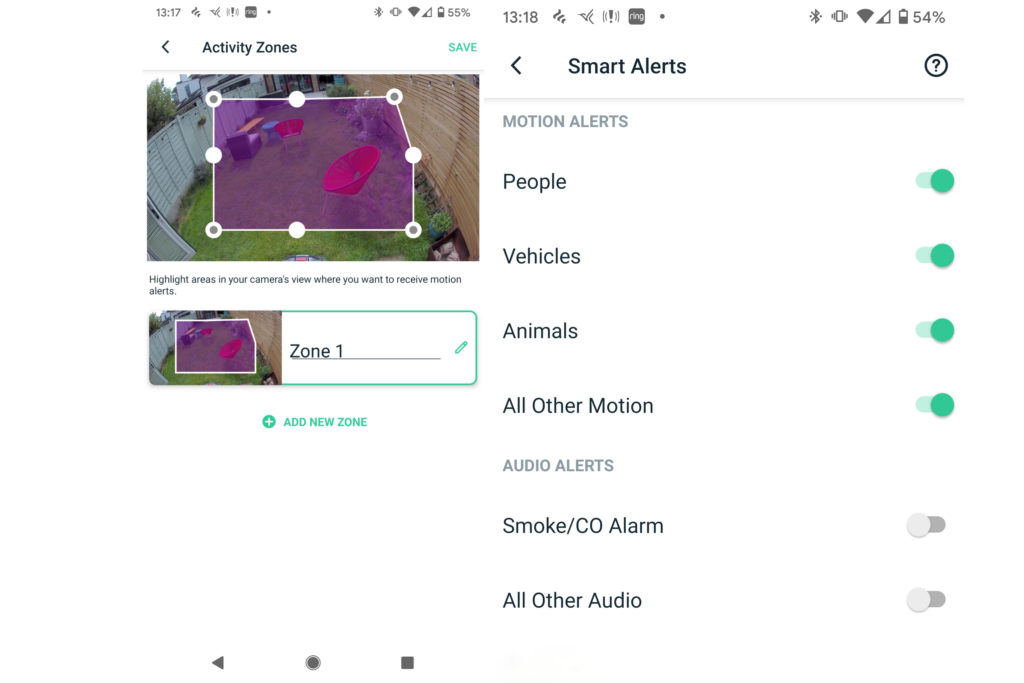
You can then use smart alerts to be told about only specific events, although everything is recorded. You get a choice of People, Vehicles, Animals and all other motion.
Object detection is very good here. Sure, there’s the occasional time when the system gets things wrong – but for the vast majority of time, the Pro 4 and Arlo Secure gets things right. You can also add Smoke/CO Alarm detection into the mix, so the cameras can alert you if your smoke alarm goes off.
All video clips are saved to the app’s library, which you can filter by date and event type. Clips get a clear thumbnail, which makes it easy to find and playback the event you’re interested in, and you can download clips to preserve footage.
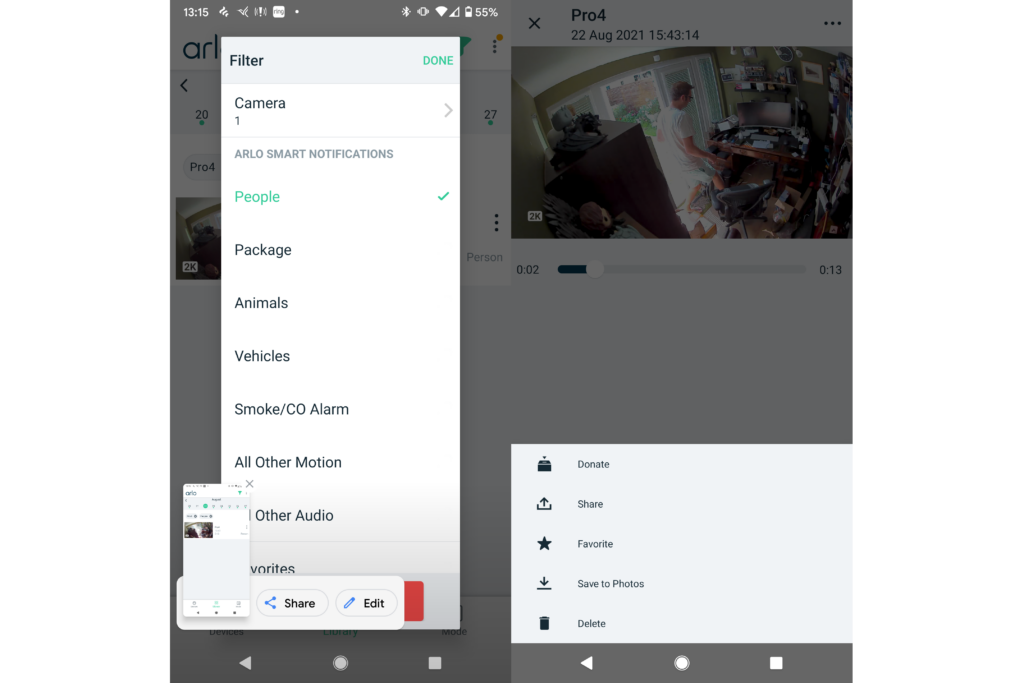
With or without a subscription, the remaining features are the same. From the app you can jump in and view the live view and have a clear two-way conversation with anyone you see. There’s an 80dB siren you can set off, too: it’s loud enough to warn someone that they’ve been spotted and may deter some thieves.
You can also flick on the spotlight manually, illuminating the area with a powerful light. This spotlight can also be configured to turn on automatically when motion is detected.
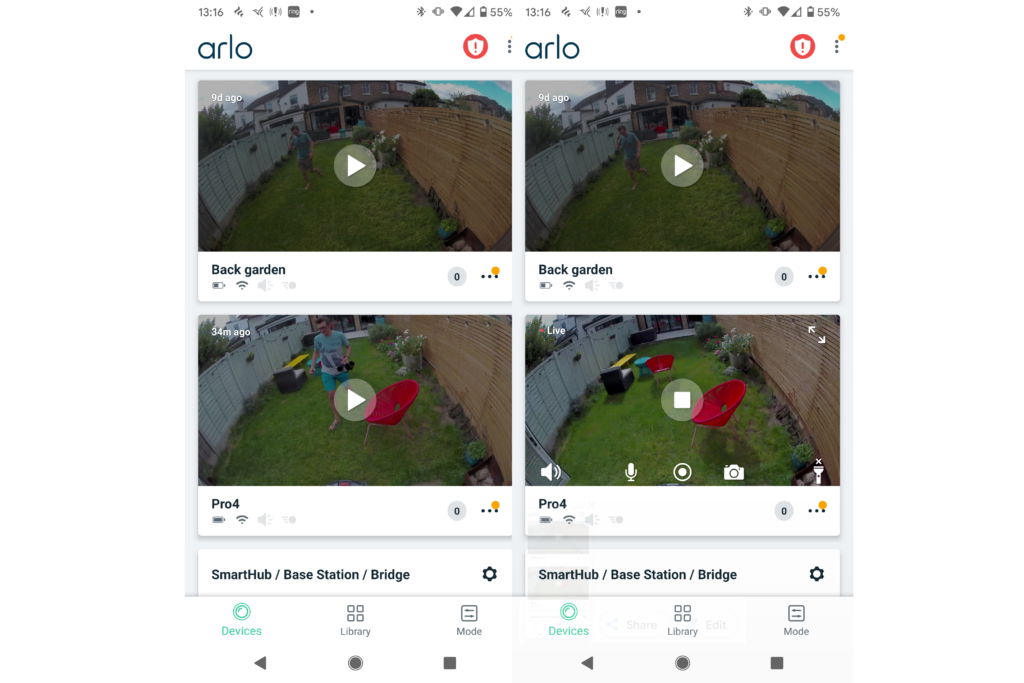
The true beauty of the Arlo system is the level of control on offer through modes. Modes simply tell the system when a camera should and shouldn’t record. If you have a base station then you can control groups of cameras together; single cameras are controlled individually, which actually makes granular control easier.
Default modes include armed (recording) and disarmed (no recording), which can be set manually – or, you can use a system such as IFTTT to select them. Alternatively, you can use a schedule, which lets you set which times cameras are active and when they’re not. And you can use geofencing to have your cameras turn on when you go out. When you get home, you can either turn your cameras off or switch back to scheduled mode. This is hugely powerful, letting you record when you want and giving you privacy at other times.
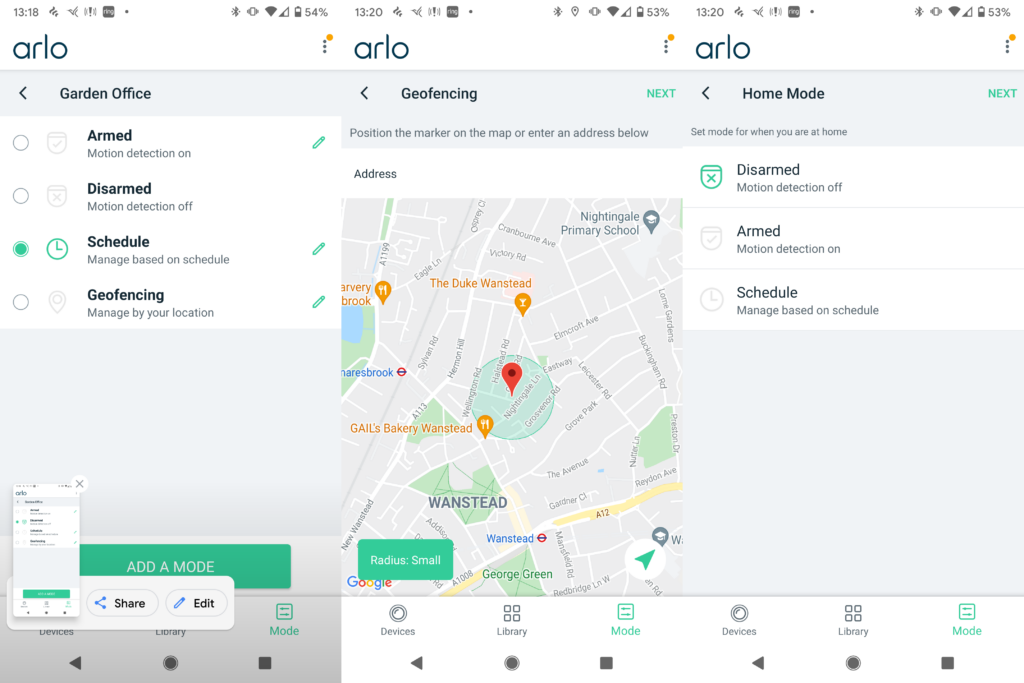
You can also set custom modes, selecting which cameras are active and which aren’t – although these modes can only be selected via the app; they don’t appear as an option with IFTTT.
The Pro 4 works with SmartThings, along with other Arlo cameras. Via this system you can view the live feed and turn the camera on or off, letting you manage the Pro 4 via SmartThings’ routines – say, turning off when you unlock a smart lock.
Amazon Alexa and Google Assistant skills are available, so you can stream footage to a compatible smart display, such as the Echo Show 10 or Nest Hub 2nd Generation. If you set up a voice PIN, you can arm and disarm with Alexa. There’s no option to do the same with the Google Assistant directly, although you can link to IFTTT to create a voice-activated applet.
HomeKit support is available, although you can only view footage through the Apple Home app; you can’t use Apple’s HomeKit Secure Video online storage.
Video quality
- High-resolution video
- Super-sharp during the day
- Full-colour night vision
With its 2K (2560 x 1440) resolution, 160-degree wide-angle lens and HDR support, the Pro 4 shoots some of the best video I’ve seen from a security camera – it’s certainly a step up from the 1080p footage you get from Ring and Nest cameras.
During the day, the quality of the footage was excellent: its sharp, detailed and extremely well exposed. You can clearly see what’s going on in every frame.
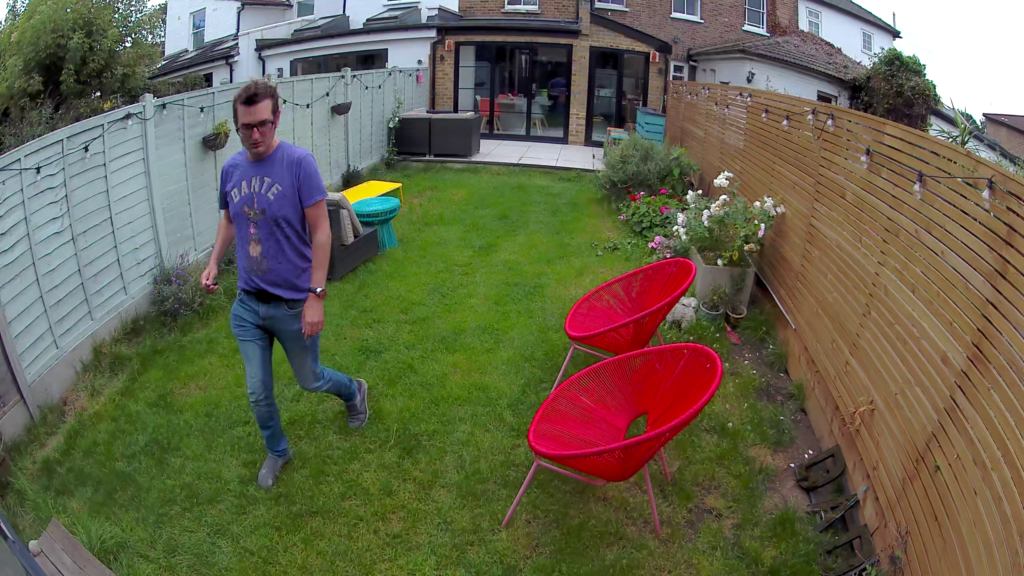
At night, the camera shot using its IR lights, giving a softer black-and-white picture. However, when the spotlight is turned on, there’s enough light to shoot video in full colour. The image is a little softer than during the day, but the high resolution means you still get plenty of detail.
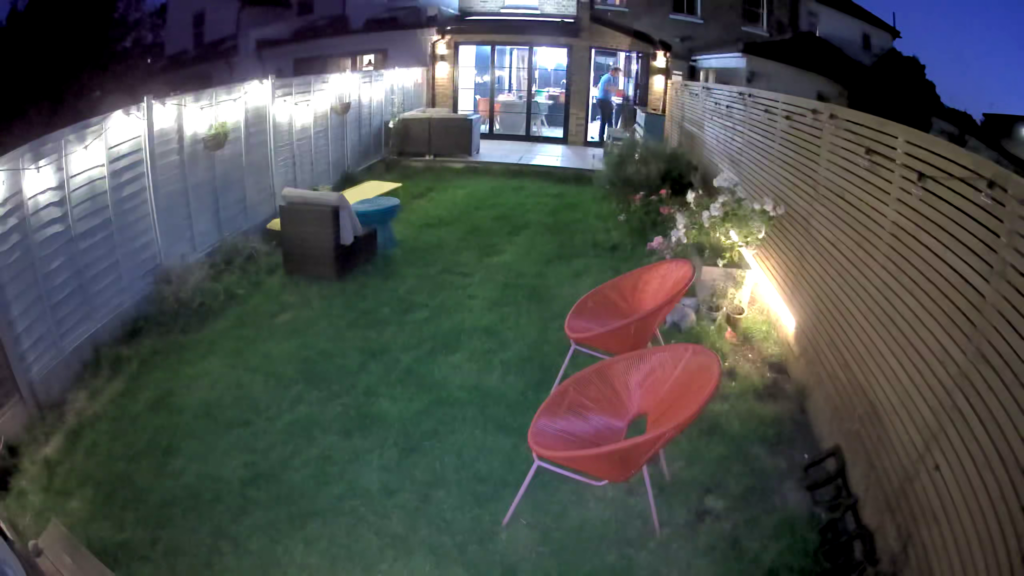
For the price and resolution, the Arlo Pro 4 is the ultimate camera.
Battery life
The original Arlo Pro 4 has battery life quoted at up to six months, although that does depend on the number of alerts that it generates. In a busy area, battery life can drop to around two months. Certainly, in my back garden, my cats can keep triggering the camera, more rapidly running down its battery life. That’s a bigger issue if I’m away, as the camera is on all of the time; when I’m at home, schedules and mode changes, mean that the camera is largely only on at night.
With the Arlo Pro 4 XL, the camera lasts a lot longer. Arlo says battery life is up to 12 months; with a lot of motion in front of it, I found that I’d get at least four months between charges, worst case scenario, if not longer. If you find that you’ve had previous battery-powered cameras that need a lot of charging, the Pro 4 XL is a good upgrade.
Latest deals
Should you buy it?
If you want excellent video during the day and night, and a super-flexible app, then the Arlo Pro 4 is for you. And, this version no longer requires an Arlo base station.
If you don’t want to pay a monthly subscription, then we’d give this camera a miss. Owners of the Ring Alarm will be better off, overall, with cameras to match the system.
Final Thoughts
I love the Arlo system and the features it offers, and the Arlo Pro 4 is the best camera in the range: its high-resolution footage is excellent. While the Arlo Ultra has 4K video, it’s far more expensive and requires a pricier Arlo Secure plan, making it harder to justify.
With the option to add in additional cameras from the range, and a choice of base station or Wi-Fi mode, the Pro 4 is the best all-round indoor/outdoor camera. If you want the camera to monitor somewhere particularly busy, then the Pro 4 XL is worth the extra £20 for the bigger case and extra large battery, although you do lose some of the convenience of being able to use a magnetic mount.
How we test
Unlike other sites, we test every security camera we review thoroughly over an extended period of time. We use industry standard tests to compare features properly. We’ll always tell you what we find. We never, ever, accept money to review a product.
Find out more about how we test in our ethics policy.
FAQs
Yes, it will connect to a base station if you prefer, but it can also connect directly to Wi-Fi.
Yes, you can use this model inside or out.
Yes, but you can only view the footage.
UK RRP
USA RRP
EU RRP
CA RRP
AUD RRP
Manufacturer
Size (Dimensions)
ASIN
Release Date
First Reviewed Date
Model Number
Resolution
Voice Assistant
Battery Length
Smart assistants
App Control
IFTTT
Camera Type
Mounting option
View Field
Recording option
Two-way audio
Night vision
Light
Motion detection
Activity zones
Object detection
Audio detection
Power source
Verdict
Cheaper than its predecessor yet offering the same excellent image quality and features, plus the option to connect directly to Wi-Fi, the Arlo Pro 4 (and Pro 4 XL) is the ultimate indoor/outdoor camera. It requires a subscription to get the most out of it, but the price is worth it. If you’re looking for a top-quality, battery-powered camera, then this is the model for you.
Pros
- Excellent quality
- Works with Wi-Fi or base station
- Smart features through cloud subscription
Cons
- Requires cloud subscription for biggest features
Availability
- UKRRP: £220
- USARRP: $200
- EuropeRRP: €249.99
- Canadaunavailable
- Australiaunavailable
Introduction
If there was one thing holding back the Arlo range of security cameras it was the need (and expense) of having to have a base station to which to connect the cameras. The Arlo Pro 4 addresses this issue, removing the need for a base station and hooking up directly to your Wi-Fi network. We also now have the Arlo Pro 4 XL, which is the same physical camera only housed in a larger case with an extra-large battery. As both have the same security features, I’ve covered them both in this review.
Cheaper than the Pro 3 it replaces, yet maintaining the same image quality and features, this is one of the best indoor/outdoor wireless cameras you can buy.
Design and installation
- Multiple mounting options
- Quick to install via the app
- Works with Wi-Fi or base station
Sit the Arlo Pro 4 next to the Arlo Pro 3 and you’re unlikely to spot any physical differences. Both cameras are sleek, white and lozenge-shaped, measuring 89 x 52 x 78mm. In the box you get a single magnetic mount that you can attach to a wall inside or out, although you can use the screw-mount underneath if you’d rather have a more flexible stand.

As with the rest of the Arlo range, the Pro 4 is powered by its internal battery. Pressing the release button once on the chassis slides the camera forward, but it stops at a locking position, so you can’t accidentally eject it onto the floor.

Once the centre has been ejected, you can remove the battery and charge it in an Arlo battery charger, if you have one. It may just be easier to remove the entire camera, battery installed, and use the provided magnetic cable. Optionally, you can buy a longer charging cable to permanently power the camera.

The Arlo Pro 4 XL has the same physical camera element, but this slides into a larger case that houses the larger battery. Again, you can charge the battery in an external charger or you can use the clip-on magnetic cable. Due to the size of the Pro 4 XL, it doesn’t work with the magnetic mount and must be attached to the screw mount. That’s similar to the Arlo Go 2, the cellular camera, which also has a larger battery.

It’s with the internals that the Pro 3 and Pro 4 differ. While the Pro 3 could connect via an Arlo base station only, the Pro 4 can connect to your standard Wi-Fi network or the base station.
The former option is likely to be cheaper for many, since you don’t need any additional hardware. It can make the camera a little more flexible to control, too, as you can see below. Some may find the base useful, as you may get a stronger connection and you can add offline recording.
Features
- Arlo Secure is required for the main features
- Excellent mode control
- Clever detection and zone control
With the Pro 4 camera you get a free trial of Arlo Secure, which provides cloud recording. If you don’t want to continue paying for storage, then you’ll get basic detection only – and, if you have a base station, the option of simple offline recording.
I don’t recommend going subscription-free, since the best features come with an Arlo Secure subscription. There are now a few more options available, too, depending on the number and type of cameras you have. Arlo Secure for one camera gets you up to 2K recording (the resolution of the Pro 4) for £2.79 a month; Arlo Secure Unlimited is £8.99 a month for any number of cameras. Both get you 30-days of history.
If you want 4K recording, as offered by the Arlo Ultra, you need Arlo Secure Plus Unlimited, which is a rather expensive £12.99 a month, although storage doubles to 60 days. Personally, unless you have a 4K camera and must have it recording at top resolution, I’d go for the cheaper package.
In all cases, Arlo’s plans are a touch more expensive than those that accompany Nest – for the Nest Cam (outdoor or indoor, battery), for example, or Ring. With Ring, you also get added goodies for the Ring Alarm.
Still, there are a lot of benefits to Arlo’s system that may make a higher monthly charge appear worth the money. First, you get activity zones, so you can focus the camera on the areas you want to record, ignoring those you don’t. Without a subscription, cameras just record when the PIR motion sensor detects movement.
It’s still worth pointing your camera carefully, since all motion will wake up the camera. It’s just that activity zones determine when the Pro 4 will continue to record. Directed properly, the Pro 4 should last around 20 weeks on a charge.

You can then use smart alerts to be told about only specific events, although everything is recorded. You get a choice of People, Vehicles, Animals and all other motion.
Object detection is very good here. Sure, there’s the occasional time when the system gets things wrong – but for the vast majority of time, the Pro 4 and Arlo Secure gets things right. You can also add Smoke/CO Alarm detection into the mix, so the cameras can alert you if your smoke alarm goes off.
All video clips are saved to the app’s library, which you can filter by date and event type. Clips get a clear thumbnail, which makes it easy to find and playback the event you’re interested in, and you can download clips to preserve footage.

With or without a subscription, the remaining features are the same. From the app you can jump in and view the live view and have a clear two-way conversation with anyone you see. There’s an 80dB siren you can set off, too: it’s loud enough to warn someone that they’ve been spotted and may deter some thieves.
You can also flick on the spotlight manually, illuminating the area with a powerful light. This spotlight can also be configured to turn on automatically when motion is detected.

The true beauty of the Arlo system is the level of control on offer through modes. Modes simply tell the system when a camera should and shouldn’t record. If you have a base station then you can control groups of cameras together; single cameras are controlled individually, which actually makes granular control easier.
Default modes include armed (recording) and disarmed (no recording), which can be set manually – or, you can use a system such as IFTTT to select them. Alternatively, you can use a schedule, which lets you set which times cameras are active and when they’re not. And you can use geofencing to have your cameras turn on when you go out. When you get home, you can either turn your cameras off or switch back to scheduled mode. This is hugely powerful, letting you record when you want and giving you privacy at other times.

You can also set custom modes, selecting which cameras are active and which aren’t – although these modes can only be selected via the app; they don’t appear as an option with IFTTT.
The Pro 4 works with SmartThings, along with other Arlo cameras. Via this system you can view the live feed and turn the camera on or off, letting you manage the Pro 4 via SmartThings’ routines – say, turning off when you unlock a smart lock.
Amazon Alexa and Google Assistant skills are available, so you can stream footage to a compatible smart display, such as the Echo Show 10 or Nest Hub 2nd Generation. If you set up a voice PIN, you can arm and disarm with Alexa. There’s no option to do the same with the Google Assistant directly, although you can link to IFTTT to create a voice-activated applet.
HomeKit support is available, although you can only view footage through the Apple Home app; you can’t use Apple’s HomeKit Secure Video online storage.
Video quality
- High-resolution video
- Super-sharp during the day
- Full-colour night vision
With its 2K (2560 x 1440) resolution, 160-degree wide-angle lens and HDR support, the Pro 4 shoots some of the best video I’ve seen from a security camera – it’s certainly a step up from the 1080p footage you get from Ring and Nest cameras.
During the day, the quality of the footage was excellent: its sharp, detailed and extremely well exposed. You can clearly see what’s going on in every frame.

At night, the camera shot using its IR lights, giving a softer black-and-white picture. However, when the spotlight is turned on, there’s enough light to shoot video in full colour. The image is a little softer than during the day, but the high resolution means you still get plenty of detail.

For the price and resolution, the Arlo Pro 4 is the ultimate camera.
Battery life
The original Arlo Pro 4 has battery life quoted at up to six months, although that does depend on the number of alerts that it generates. In a busy area, battery life can drop to around two months. Certainly, in my back garden, my cats can keep triggering the camera, more rapidly running down its battery life. That’s a bigger issue if I’m away, as the camera is on all of the time; when I’m at home, schedules and mode changes, mean that the camera is largely only on at night.
With the Arlo Pro 4 XL, the camera lasts a lot longer. Arlo says battery life is up to 12 months; with a lot of motion in front of it, I found that I’d get at least four months between charges, worst case scenario, if not longer. If you find that you’ve had previous battery-powered cameras that need a lot of charging, the Pro 4 XL is a good upgrade.
Latest deals
Should you buy it?
If you want excellent video during the day and night, and a super-flexible app, then the Arlo Pro 4 is for you. And, this version no longer requires an Arlo base station.
If you don’t want to pay a monthly subscription, then we’d give this camera a miss. Owners of the Ring Alarm will be better off, overall, with cameras to match the system.
Final Thoughts
I love the Arlo system and the features it offers, and the Arlo Pro 4 is the best camera in the range: its high-resolution footage is excellent. While the Arlo Ultra has 4K video, it’s far more expensive and requires a pricier Arlo Secure plan, making it harder to justify.
With the option to add in additional cameras from the range, and a choice of base station or Wi-Fi mode, the Pro 4 is the best all-round indoor/outdoor camera. If you want the camera to monitor somewhere particularly busy, then the Pro 4 XL is worth the extra £20 for the bigger case and extra large battery, although you do lose some of the convenience of being able to use a magnetic mount.
How we test
Unlike other sites, we test every security camera we review thoroughly over an extended period of time. We use industry standard tests to compare features properly. We’ll always tell you what we find. We never, ever, accept money to review a product.
Find out more about how we test in our ethics policy.
FAQs
Yes, it will connect to a base station if you prefer, but it can also connect directly to Wi-Fi.
Yes, you can use this model inside or out.
Yes, but you can only view the footage.
UK RRP
USA RRP
EU RRP
CA RRP
AUD RRP
Manufacturer
Size (Dimensions)
ASIN
Release Date
First Reviewed Date
Model Number
Resolution
Voice Assistant
Battery Length
Smart assistants
App Control
IFTTT
Camera Type
Mounting option
View Field
Recording option
Two-way audio
Night vision
Light
Motion detection
Activity zones
Object detection
Audio detection
Power source



















